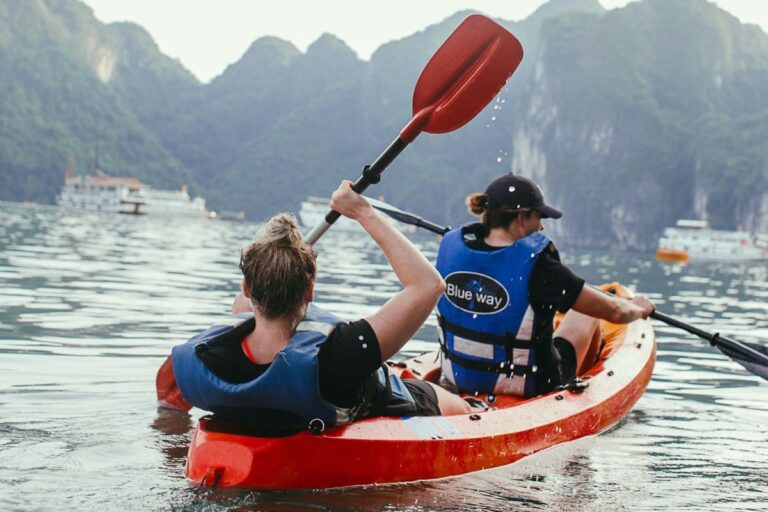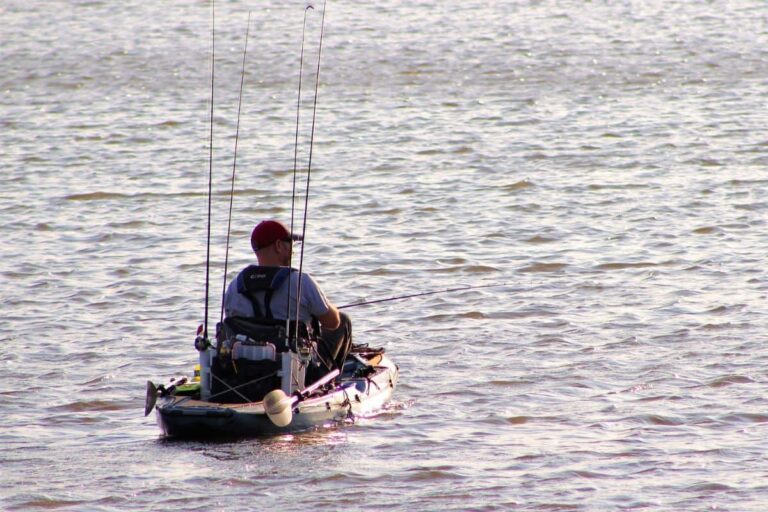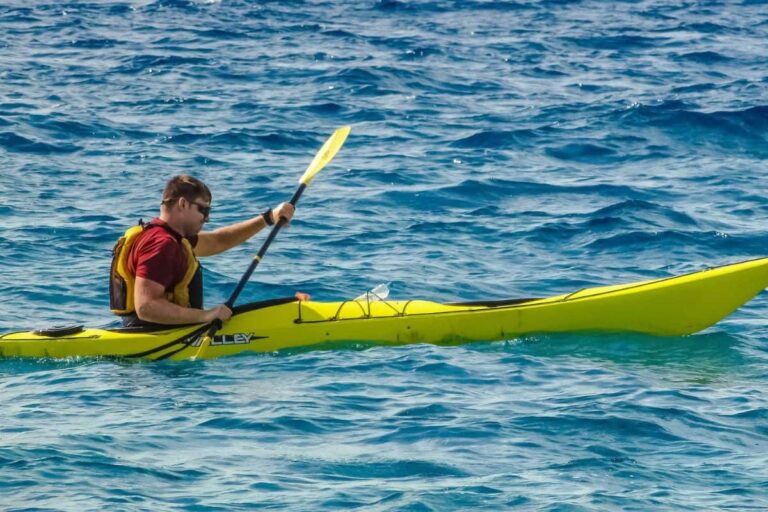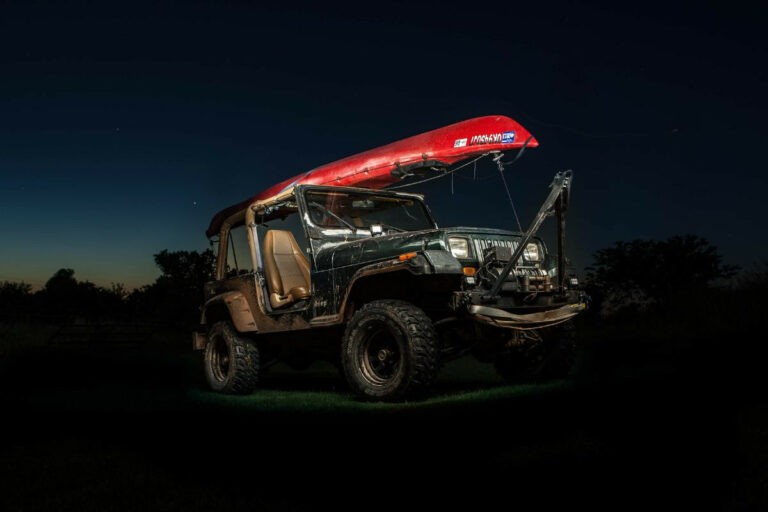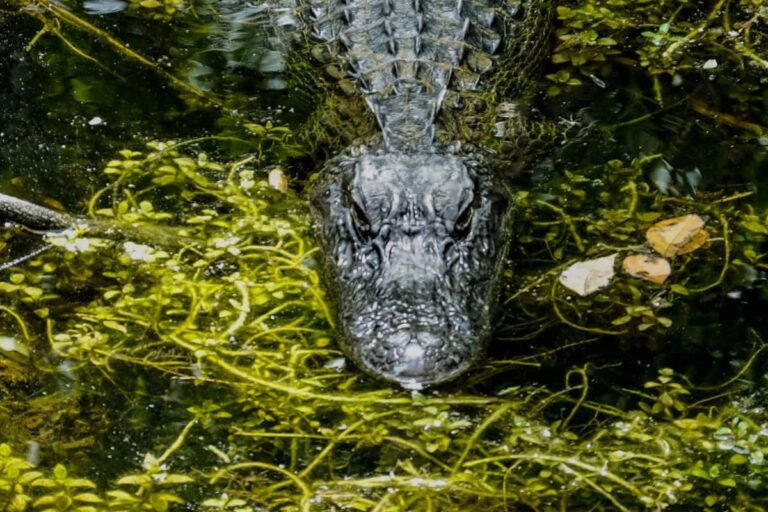Which Muscles Does Kayaking Work? (5 Muscle Groups)
If you enjoy kayaking, you might be wondering what kind of workout you can get from this activity.
Are you curious which muscles are impacted by paddling a kayak?
Every kayak stroke works the upper body, lower body, and abs, as well as many other muscles in your core. The five major muscle groups that paddling a kayak works are the back, shoulder girdle, abdominal area, legs and core muscles.
In this article, we will take a look at each of these areas in more detail, and learn why kayaking is such a good workout for these specific muscles.
Kayaking And Your Health
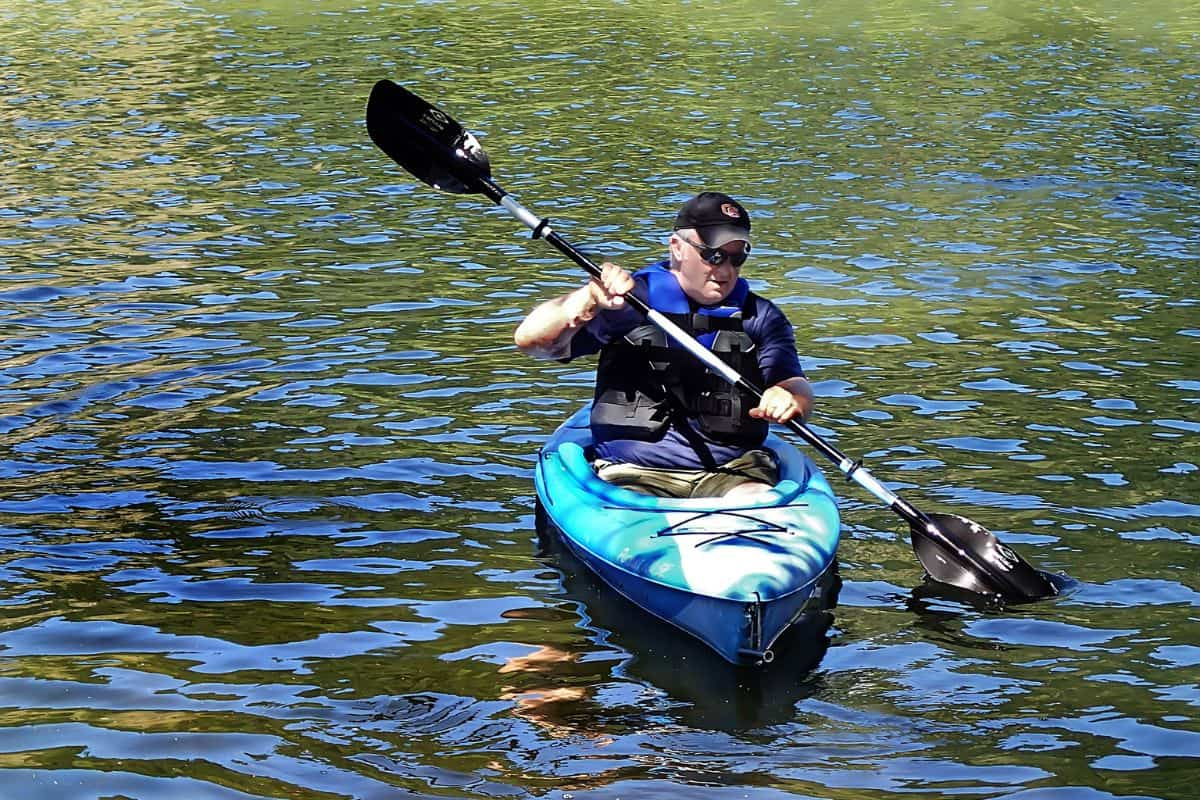
Paddling through any body of water requires a lot of stamina and strength. When kayaking, you are using mainly your arms, back, and chest muscles as you push yourself forward through the water.
When you use the proper kayaking technique to move your boat forward, the shoulder and back muscles are significantly engaged as you twist.
Unlike other sports where you may get away with using a one-arm motion to propel yourself, kayaking requires a more symmetrical twisting motion.
This provides a good workout for the same muscles on each side of the upper body.
The abdominal muscles are also engaged while kayaking.
This is because it takes strength and stability in the trunk of your body in order to steer the boat and avoid hitting obstacles or going off-course.
You also may have to lift your knees up to your chest in order to sit with proper posture for various kayaking techniques. This action tightens the abdominal area which, in turn, helps with control and steering.
When kayaking down rapids, you need to use the kayak paddle to brace yourself against rocks and other obstacles. There are different techniques used to brace yourself so that you prevent injury, and these motions engage many muscle groups.
These movements not only work the abs, but they also engage your legs as well. For example, if you’re trying to execute a brace maneuver before bumping into rocks or trees, your feet will need to push against the kayak’s foot braces to help with balance and avoid a kayak roll.
5 Muscle Areas Worked By Kayaking
So which muscles are worked as you propel your kayak forward? There are four main muscle groups that are engaged and strengthened during every paddling session.
1. Back Muscles
Kayaking works the back muscles because of the twisting motion that is required to paddle the boat.
There are four main muscles in your back: the latissimus dorsi, trapezius, rhomboid, and erector spinae.
The latissimus dorsi stretches along the side of your body from your lower back all the way up to the armpit. Your arm pulls through this muscle with each forward paddling motion, which allows you to use the muscles in your back to push yourself forward.
The trapezius muscles are located at the base of your neck on either side of your spine.
The upper traps tense up whenever you have to bring your arms close to your body in order to paddle fast. These muscles are also engaged any time you raise your paddle to avoid an obstacle.
The middle and lower traps help you to maintain stability through each paddling motion.
The rhomboid muscles are found under the trapezius muscles on either side of your spine, between your shoulder blades.
Paddling is great exercise for these muscles, because you use them when you lift up your blade to feather it, or when you need to brace against an object.
The erector spinae is a group of muscles located along your spine on either side of your back.
In order to keep your kayak from rocking from side to side, this muscle group tenses as you pull yourself forward and maintain good posture throughout your kayaking session.
2. Shoulder Girdle Muscles
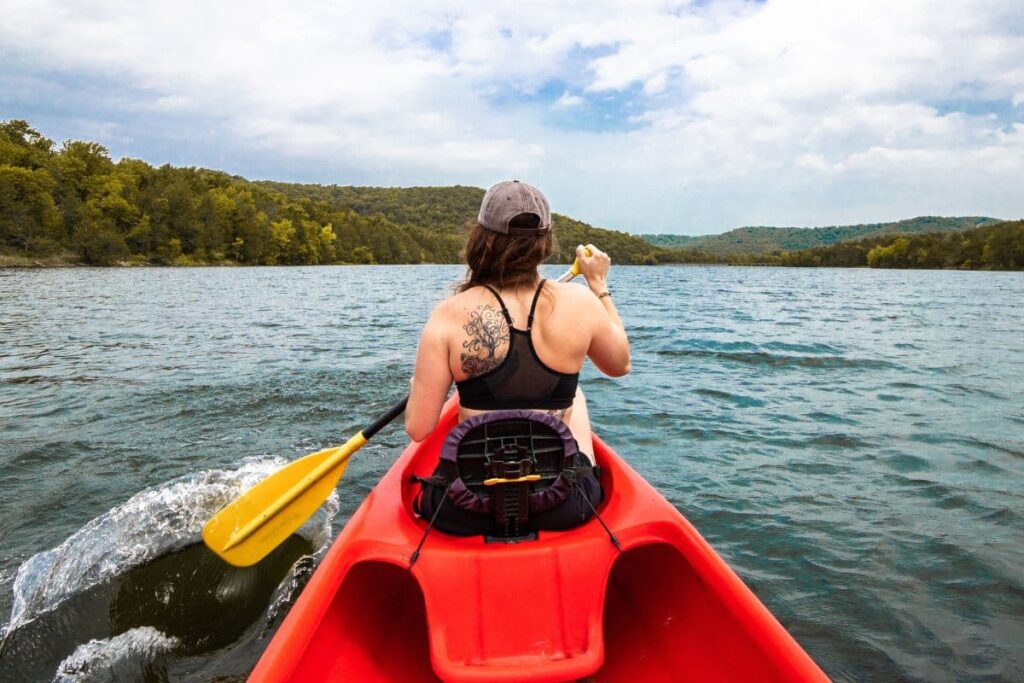
Kayaking works the shoulder girdle muscles because of the rowing and lifting motions required to paddle efficiently.
The shoulder blades, also known as “scapulae”, need to be strong enough to endure the pressure placed on them during kayaking. They are one of the main sets of shoulder muscles that are worked while you kayak.
The shoulder girdle muscles have a significant impact on the level of control for each paddling stroke you perform, and they work together with the chest muscles to move your paddle back and forth.
The paddling effort required for kayaking is said to be just as beneficial to your shoulder muscles as a seated cable row session at the gym!
The teres major muscle works with the latissimus dorsi as your arm extends in order to help you paddle forward using feathered strokes. This particular muscle stretches from the upper part of your back all the way to your armpit area.
The latissimus dorsi is located in your mid-back along the spine. This muscle is used when you pull yourself forward while paddling or feathering.
Since kayak paddles have blades at each end, you are executing a somewhat one-armed row with each stroke. Beginners will likely need to build strength in their latissimus dorsi because of how much strength it takes to paddle using primarily one arm at a time.
The deltoid is located at the top of your shoulder near the middle part of your body. This muscle is used when you push yourself up against an obstacle while bracing, or doing arm pulls to paddle forward with no obstacles in front of you.
The supraspinatus, one of the rotator cuff muscles, is found underneath your shoulder blade. These muscles help you maintain control, because they’re used when you have to keep yourself from swaying side to side while paddling.
Rotator cuff injuries can be painful, so it’s recommended that you build this muscle slowly. It’s also important to take a break if it starts to tense up while paddling.
The rotational force that’s generated as you paddle can be quite strong, so it’s best to start out on calm waters as you build strength in your supraspinatus.
Both sets of biceps are used for control in every good kayaking stroke. These muscles are responsible for power transfer to the forearm muscles, which affects the speed of each paddle and keeps propelling your kayak forward.
3. Abdominal Area Muscles
The abdominal area muscle groups help with bracing and other aspects of kayaking in general. “Bracing” refers to a technique that helps you stay in a straight line while paddling down a fast-moving river or through rough water.
Strong abdominal muscles are needed in order to be able to balance yourself while bracing against the pressure that is placed on your body by the water currents. The main compound muscles that get a good workout in this area are the rectus abdominis, obliques, and transverse abdominis.
The rectus abdominis, commonly known as your “abs”, stretches across your mid-section from front to back. This muscle area is worked, even during a leisurely paddle, because it helps you maintain control while pulling yourself forward or bracing against an obstacle.
The obliques are located along the side of your body next to your rectus abdominis muscle. They are similar to your latissimus dorsi, because they are especially engaged when you execute the torso rotation that’s necessary for every paddling motion.
The transverse abdominis wraps around your spine and is mainly worked when you have to brace. This helps with control because it keeps your torso balanced while paddling, allowing you to maintain proper posture in your upper body.
4. Legs
Believe it or not, kayaking also works your legs, since they play an important role in controlling your kayak by keeping you balanced.
The leg muscles that are worked by kayaking include the gluteus maximus, biceps femoris, semitendinosus, and semimembranosus.
The gluteus maximus stretches from the top of your hip all the way to your pelvic bone and is used to keep your entire body stable when paddling forward.
The biceps femoris is located on the back of your upper leg. This muscle works together with your gluteus maximus in order to push yourself against an obstacle while bracing or doing one-arm rows.
The semitendinosus and semimembranosus muscles are located on the back part of your thigh. These muscles help with paddling because they are used to push you forward while feathering or bracing one-armed against an obstacle.
5. Core Muscles
Last but not least, kayaking works the core muscles, which includes all of the smaller muscles that run along your midsection and outer thighs. These muscles help with bracing, and all kayaking in general, by keeping your body stable as you encounter rough water.
The main compound muscles in this area are the pectoralis major, latissimus dorsi, serratus anterior, rectus abdominis, and obliques.
The pectoralis major is located under your breast area on either side of your chest. This muscle gets a great workout as you paddle because it’s used during every arm row.
The latissimus dorsi is located in your midsection along the spine, just before meeting the back of your armpit area. These muscles help with paddling because they are used to pull yourself forward with each row.
The serratus anterior is located along the scapula, and helps with bracing by pulling your body up and holding it tight as you encounter an obstacle.
The rectus abdominis stretches from front to back at the top of your stomach, and works together with the obliques and the transverse abdominis in the same manner to help you brace.
The transverse abdominis is located around your midsection and wraps around your spine. This muscle, along with the aforementioned muscles in your core, helps you brace as you pull yourself forward against an obstacle.
How does kayaking work your leg muscles?
Your leg muscles are worked less than the muscles of your upper body during kayaking, but they are still involved in the overall activity.
The main job of the leg muscles here is to help the kayak stay balanced and controlled.
To do this, you will likely find yourself subconsciously keeping the muscles in your lower body tensed and tight.
Is kayaking a sport that requires a lot of stamina and strength?
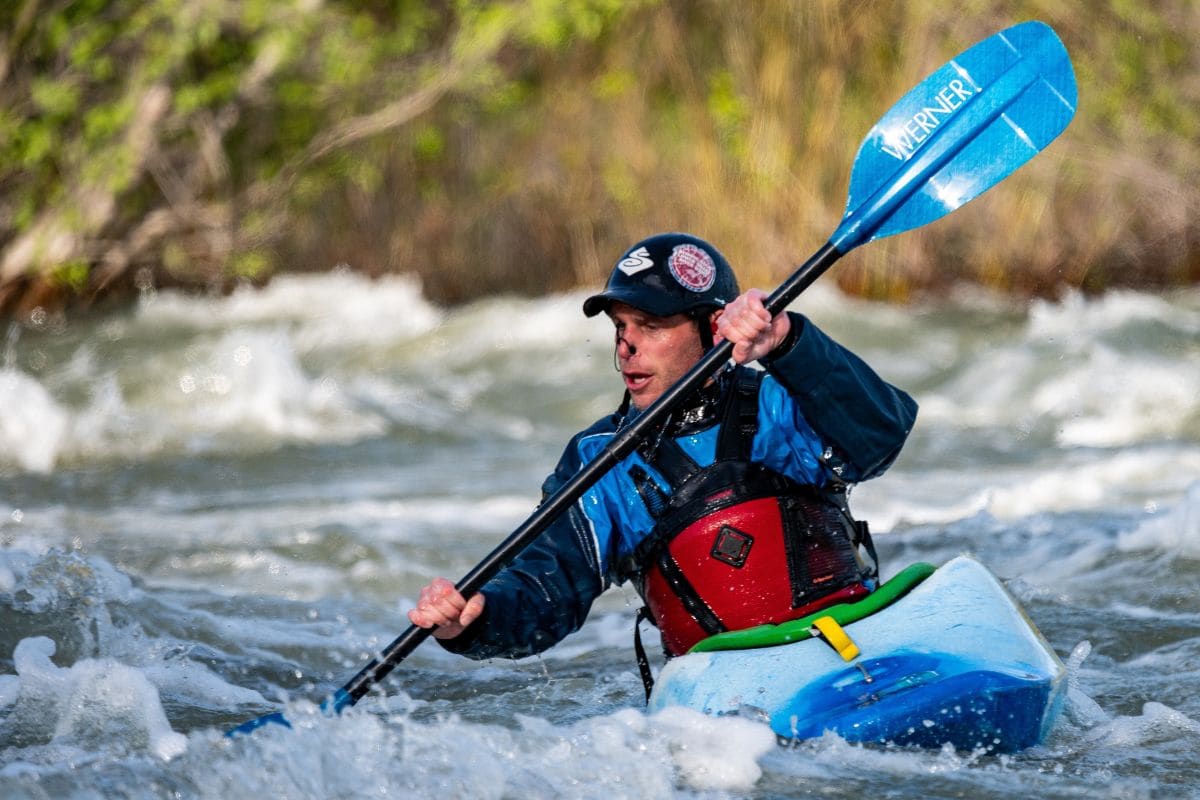
Yes, the four main muscle groups that kayaking works are the back, shoulder girdle, abdominal area, and legs.
Paddling a kayak works your upper body, lower body, and abs, as well as many other muscles in your core.
Kayaking is also a great cardiovascular exercise. A good cardio workout will get your blood pumping and your heart rate up.
The nearly-constant paddling motion that is required to kayak keeps your heart working hard and helps you burn calories.
One of the other health benefits of kayaking is that it helps you to maintain a strong core, which in turn increases your balance both in and out of the boat.
Can kayaking damage muscles?
Sometimes. It’s important to build up strength and stamina in order to paddle for long periods of time. If your muscles aren’t used to a consistent workout routine, you will likely experience total body fatigue after a kayaking trip.
Kayaking can tire out your arm muscles, and really all the muscles in your upper body, so much that they are sore for several days afterwards. So be sure to give yourself plenty of time to rest between kayaking trips.
But remember, the more often you kayak, the stronger these muscles will become over time. Maintaining a regular kayaking routine will help you build strength, which in turn will help you avoid wrist injuries and other muscle damage.
Regular exercise like kayaking can also help you lose weight, since even leisurely kayaking burns calories and benefits a variety of muscle groups.
How long does it take for muscles to build strength and stamina?
This depends on many factors, including your particular age, weight, and gender, among others.
Generally speaking, the older you get, the longer it takes to build up endurance in your muscles. This is because aging causes a decrease in muscle tissue, and also a decreased ability to repair muscle fibers after they are damaged.
Conclusion
Kayaking is a great way to give your body an overall workout.
Paddling a kayak works four major muscle groups in particular, including the back, shoulder girdle, abdominal area, and legs.
If you are new to kayaking, remember to take it slow as you build up your body’s strength and endurance to avoid injury and fatigue.
Now that you know about all of the health benefits of kayaking, it’s time to get out there and paddle!
Table of Contents

